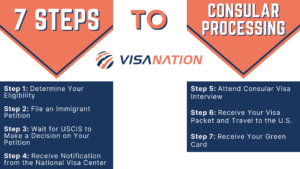Green Card Consular Processing Advantages and Disadvantages
Consular processing is a method by which a beneficiary of an approved family-based, employment-based or other immigration petition can apply for a visa through a U.S. Department of State consulate office abroad. There are many benefits when it comes to green card consular processing. However, you must first determine if you fit into an eligible immigrant category that permits this form of processing.
What is Consular Processing
Consular processing is the process by which foreign residents can apply for a U.S. green card, either through family-based immigration or employment immigration. To apply for lawful permanent residence through consular processing, you must apply from outside of the United States. The entire application process will go through your country’s U.S. consulate or embassy. Keep in mind that you will have to remain in your home country while your application is being processed.
Consular Processing Eligibility
In the majority of cases where you are applying for U.S. immigration from outside of the U.S., you will be required to go through consular processing. The eligibility for consular processing also greatly depends on your eligibility for the green card that you are applying for. If you are ineligible, then your consular processing application will unlikely be considered.
It is important to note that in some instances, applicants may have a choice between applying from within the U.S. or outside the U.S. through consular processing. In those situations, applicants must choose the method that benefits them most. This can be a big factor as consular processing usually takes much longer than applications from within the U.S.
7 Steps to Getting a Green Card Through Consular Processing
There are many benefits to choosing consular processing as we’ll illustrate, including enhanced convenience and a moderate degree of flexibility. The following are the steps involved in getting a green card via consular processing.
Step 1: Determine Your Eligibility
The first step toward getting a green card through consular processing is to determine if you qualify to apply and which category you are eligible to apply for. Most of the green card categories require having a U.S.-based citizen, permanent resident, or organization sponsor your visa. The two popular routes are through employment or family. For these categories, you will most likely need a sponsor while other routes include investment options or refugee and asylee status. You can check the green card eligibility categories available to determine the one that best suits your situation.
Step 2: File an Immigrant Petition
Once you know that you qualify for consular processing, you’ll usually have an immigrant petition filed on your behalf. Depending on which category you fit in, however, the steps differ.
Employment-Based Green Card Process: If you are pursuing any of the green cards under the employment-based categories, the process will start by submitting a petition with the USCIS. Except in a few cases where self-petitioning is allowed, an employment-based green card petition is submitted by a U.S. employer on behalf of a foreign national. This is to demonstrate that the employer has given you a job offer and is willing to sponsor your immigrant visa to migrate to the United States. So, in this case, the U.S. employer will need to file an I-140, Petition for Alien Worker. However, if you qualify for a self-petitioning employment-based green card, you can file your I-140 petition yourself.
Investor Visa Green Card: Similar to the employment-based categories is the investor green card, popularly called EB-5 green card. This category requires you to prove that you have an investment amount worth $800,000 or $1.05 million and you are ready to invest it in the U.S. economy. The major difference between this and most employment-based visas is that you will be the one to self-petition the USCIS by filing Form I-526, Immigrant Petition by Alien Investor.
Family-Based Green Card: This category requires you to have a qualifying family relationship with a U.S. citizen or a lawful permanent resident who is eligible and ready to sponsor your green card. You may qualify under this category if you are a spouse, child, parent, or sibling of a U.S. citizen or permanent resident. Bear in mind, however, that the qualifying relationships are somewhat different for relatives of a U.S. citizen and permanent resident. You can check the eligibility requirements for various family-based green cards to be sure of your qualification. The U.S. citizen or permanent resident will have to file Form I-130, Petition for Alien Relative, with the USCIS.
Special Categories and Humanitarian Programs: You may also qualify for a green card under the special case categories or humanitarian programs. Just as their names imply, these categories are only open to a certain category and have their separate modes of application.
Step 3: Wait for USCIS to Make a Decision on Your Petition
After submitting the appropriate petition based on your immigration status, you’ll need to wait for a decision from USCIS, which could be either approval or denial. If you receive approval and want to apply for your immigrant visa overseas, then USCIS will send the approval to the designated visa center until a visa number becomes available.
It’s important to first acknowledge that there are two different entities involved in the immigration visa consular process system–the National Visa Center and the designated Consular Office overseas. If your petition is approved, USCIS will send it to the NVC, and it will remain there until there is an availability of an immigrant visa number for you, based on your position on the green card waiting line. You can see a complete list of priority and availability dates on the USCIS official website.
Step 4: Receive Notification from the National Visa Center
When the immigrant visa number is about to become available, the NVC will notify you and your sponsor about it. The notice will also include the details of items you will need to submit and when you are expected to submit them. It will also include the required immigrant visa processing fees you are to pay. The exact supporting documentation for your case will depend on the green card category you are pursuing. In general, however, you will need to complete a DS-160 or DS-260 Online Nonimmigrant/Immigrant Visa Application and bring a printout of the confirmation page with you.
Step 5: Attend Consular Visa Interview
Once your priority date becomes current (or a visa number becomes available), the next step is your consular appointment. The consular office will schedule you for an interview and also tell you which documents to bring along to the interview. The documents may vary among consular offices, but in most cases, you will need to bring the following items to your interview appointment:
- A valid passport and any old or expired passports
- A photograph of you according to the Department of State requirements.
- The receipt of your DS-160 or DS-260 fee payment
- Evidence of your qualification for the visa or green card sought
- Resume or CV (for employment-based cases)
Step 6: Receive Your Visa Packet and Travel to the U.S.
If you are granted an immigrant visa after the consular interview, the consular officer will give you a packet of information containing the documents you need to travel to the United States. This packet is called a visa packet. Please, do not open the packet. It must be taken to the U.S. sealed. After receiving your visa packet, you will need to pay a USCIS Immigrant Fee.
After that, you can start your travel plans to the United States. Upon your arrival at the U.S. border or airport, a U.S. Customs and Border Protection (CBP) officer will collect and check the visa packet and determine whether to admit you into the U.S. If the CBP officer considers you eligible, you will be admitted as a lawful permanent resident. From then on, you are able to live and work permanently in the United States.
Step 7: Receive Your Green Card
Your green card may not be available on the day you enter. It usually takes some days or weeks before you can receive it. It is, in most cases, within 45 days, provided you had paid the USCIS immigrant fee after receiving your visa packet. However, this will not in any way affect your permanent resident status for the duration it takes to get the card.
Once you have been admitted as a permanent resident, you are entitled to all the benefits attached to your status even in the absence of the physical green card. If after 45 days, you haven’t received your green card, you should contact USCIS.
How Long Does Consular Processing Take
The timeline for green card consular processing will depend on various factors. The most important factor is the visa category you are pursuing. In the family-based category, for instance, the marriage-based green card is the quickest subcategory, especially if it is being sponsored by a U.S. citizen.
Another factor is your country of origin. Some countries have a large number of nationals applying for green cards under certain categories. This usually results in backlogs, leading to a long waiting list.
The workload and staffing at the consular office in charge of your case is another factor. Some consulates or embassies schedule interview appointments faster than others. You will also need to factor in the level of readiness between you and your sponsor. It is important to get every required document ready and put them in order to avoid delays.
Lastly, your green card consular processing can also be accelerated by working with an immigration attorney who can guide you through and help you avoid errors that can cause delays or denial.
Consular Processing Fees
Consular processing fees vary among various green card categories. For the family-based green card, the Form I-130 filing fee is $535 while the application processing fee will cost you $325. So, in total, the beneficiary and/or the petitioner will spend $860.
For employment-based categories, the total amount is $1,045. Bear in mind, however, that there is also an immigration medical examination. This will be conducted by a physician designated by the consulate or embassy. The fee for medical examination varies widely among different physicians. Also, if you are hiring an immigration attorney, you will have to factor in the attorney fee, which also varies depending on the law firm you are consulting.
What if my petition is denied?
If you receive a denial you’ll also be provided reasons for why the petition is denied as well as your options to appeal the denial. You will want to work very closely with your immigration attorney in order to determine your options after a petition denial. There may be other avenues available for you to obtain your green card.
Consular Processing vs Adjustment of Status
Wondering if consular processing or an adjustment of status is more favorable? One of the most significant advantages of green card consular processing is the speed at which it gets adjudicated. In most cases, the average consular processing time ranges between 6 and 12 months while an adjustment of status can sometimes take upwards of a few years.
As you can see, the time frame is significantly shorter for green card consular processing cases. That’s not to say, however, that an adjustment of status may not be the preferred option. With an employment-based adjustment of status, you have the ability to simultaneously apply for advance parole which allows you to re-enter the United States without an immigrant/nonimmigrant visa after traveling abroad.
In either case, your processing time will heavily depend on the service center or U.S. consulate that is responsible for your case. Some people have reported having to schedule their consular interview many months in advance while others only have had to wait a few weeks.
On the other hand, the I-485 application to adjust your status to lawful permanent resident could take as little as 4 months or as long as a year. It depends on the service center’s caseload.
Learn more about the benefits of an employment-based adjustment of status as well as the documents required. Among other things, adjusting your status happens automatically once the application is processed and does not require you to leave the country or go through an interview.
What To Do After Consular Processing
Depending on the visa that you have applied for, the steps after consular processing will differ. After all, this is just an application process for the visa that you initially applied for.
For example, if you applied for a CR-1 visa, which is an Immigrant visa for a Spouse of a U.S. Citizen, then after consular processing, you will receive a 2-year conditional permanent residence. This means that after the 2 years, you will have to apply to remove the conditions on your green card and receive 10-year unconditional residence. On the other hand, if you applied for an IR-1 visa, which is also a visa for an immigrant spouse, then you will receive a 10-year permanent residence straight away.
Thus, it is crucial to check with your immigration attorney as to what steps you should take after completing consular processing and receiving your green card.
Green Card Consular Processing FAQs
Below are some of the most frequently asked questions regarding green card consular processing. If you have additional concerns, please contact one of our employment immigration attorneys to schedule a consultation.
Q. Who is consular processing ideal for?
Any individual (who meets the necessary criteria) can apply for green card consular processing once their visa petition has been approved by USCIS (i.e., EB-2 consular processing). For immigrants living overseas, this is typically the go-to method since it is significantly more difficult to enter the U.S. in an attempt to complete their application.
Similarly, some individuals may not be eligible for adjustment of status (i.e., expired visa status) so there really is no alternative but to leave the U.S. and apply for consular processing abroad. If you are already in the U.S. under a different nonimmigrant visa, then speak with your immigration attorney to learn if consular processing is best for your unique situation.
Q. At what point does immigration visa consular processing begin?
Consular processing begins once the initial petition has been approved by USCIS and your priority date and/or visas become available.
Q. What’s generally the time frame you should expect?
As previously mentioned, the processing time varies. However, you should expect anywhere from 6 to 12 months. Contact an immigration visa consular processing attorney to learn more about your particular situation.
Q. Is there a difference in the cost?
For green cards, there is a difference in the required fees. The most prominent difference is that adjusting your status requires an I-485 application with a filing fee of $1,140-$1,225 depending on how old you are.
On the other hand, green card consular processing requires that you complete the DS-260 and pay the $220 fee as well as the $120 fee for the Affidavit of Support. You may also need to pay the $85 biometrics fee.
Q. What happens if my priority date is not current when my I-140 is approved?
If you find that your I-140 is approved, but your priority date has not yet become current, then the I-140 will be kept on file with the National Visa Center until the priority date becomes current. At the point when your priority date does become current, the National Visa Center will send you Packet 3 and then forward your file to the proper consular post.
Q. Can I switch from the consular process to an adjustment of status?
If you’ve begun consular processing and wish to switch to AOS, you need to file the adjustment of status application with USCIS and inform the consular as well as the National Visa Center of your decision to switch.
How VisaNation Law Group Immigration Attorneys Can Help
Choosing between adjusting your status and going through consular processing can be difficult. Just like any other aspect of immigration law, it’s not a good idea to attempt anything alone. Having an experienced immigration attorney at your side can save you both time and money as well as help you handle any unexpected situations.
VisaNation Law Group lawyers have an excellent track record when it comes to cases involving consular processing and adjustment of status. We specialize in a range of employment-based immigration visas, including EB-1, EB-2, EB-3, PERM and PERM Audit, EB-4, and EB-5 visas. Contact us to receive a comprehensive consultation and learn more about our firm’s offerings.







